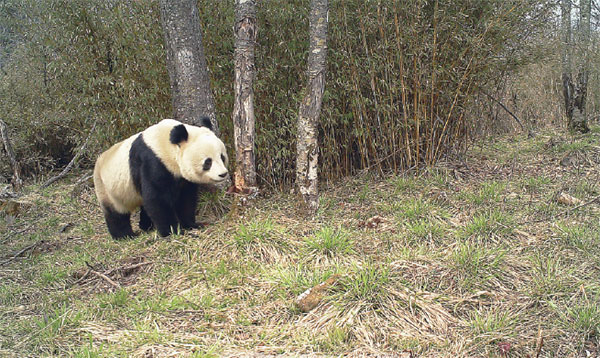New eyes on pandas
|
An infrared camera captures a wild giant panda roaming the woods of Shaanxi Zhouzhi Nature Reserve. Provided to China Daily |
Wireless surveillance and infrared cameras will vastly expand data available to forest rangers and conservationists. Xu Lin reports on how this may help save the endangered animal.
For the past 32 years, forest ranger Li Xifeng's daily routine is patrolling the deep woods of Heihe National Forest Park in Zhouzhi county, Shaanxi province, to protect the habitat of wild giant pandas and prevent forest fires.
But since the end of October, Li and his colleagues can monitor the situation from their office most of the time via newly installed wireless surveillance and infrared cameras.
They are part of the Giant Panda Habitat Monitoring and Restoration Demonstration Program in China's Western Mountainous Areas, co-started by World Wildlife Fund and computer hardware manufacturer Seagate Technology.
The program has chosen three representative habitats of wild giant pandas - Shaanxi Zhouzhi Nature Reserve and Heihe National Forest Park, Sichuan Xiaohegou Nature Reserve and Gansu Duo'er Nature Reserve. The wild pandas are only found in these three provinces.
With Seagate's financial and technical support, WWF aims to help researchers in these habitats to establish surveillance systems, gather and analyze data, detect potential threats and deal with them.
According to China's Fourth National Giant Panda Survey this year, supported by WWF, the estimated minimum population of wild giant pandas in the country is 1,864, with an increase of 16.8 percent over the past decade.
"To protect captive giant pandas, the focus is breeding. But for wild ones, it's about protecting their habitats and increasing their interactions among populations," says Li Yang, an official with the WWF's giant panda program.
"The giant panda's habitat is also home to species such as the golden snub-nosed monkey and red panda. We can protect these animals and the whole ecological system such as woods and freshwater via protection of the habitats. It will also benefit the human beings in the end," he says.
There are seven high-definition wireless surveillance cameras in essential places of the Heihe park to monitor the behavior of tourists. Rangers can control the cameras from their posts and watch real-time images transmitted through the network.
"The park is very large. The surveillance cameras can tell us where tourists are going and what they are doing. Then we will know how to tackle their interference in the habitat and educate them to protect the environment," Li says.
He says the surveillance can prevent the traditional threats to giant pandas - cutting down trees, illegal hunting and mountain fires and obtain evidence to prosecute such crimes.
These threats have been reduced in the recent years due to economic development, Li says, and the increase of awareness of wild animal protection.
"But there are new threats such as the interference of tourism development and habitat separation caused by infrastructure projects including roads, rails and dams. The challenge is how to balance these demands and protect the precious animals," says Wan Hui, the director of WWF's giant panda program.
"It's effective to manage the habitats with better information. It means there will be huge amounts of data about the habitats, animals and plants. In animal-protection work, technology can help human beings do what they cannot do," Wan says.
The habitats in Sichuan and Shaanxi are close to tourism sites and the main focus would be to monitor human traffic and educate tourists. WWF has community projects to help the local residents to make a living, such as hosting environment-friendly farm stays.
Each April and July, the forest rangers take 27 fixed routes in the Heihe park's remote woods to collect data about wild animals - including their excreta, hair and animal sightings - and analyze them to estimate the number of animals.
Organizers of the demonstration program set up about 30 infrared cameras in the woods that take photos automatically when a living being passes by.
"In the past, we took photos of wild animals if we bumped into them while collecting data. The infrared cameras work day and night, and make it more likely to capture their precious images. Moreover, we can trace the scope of their activity and life habits because we know the positions of the cameras," says Wang Pengzhou, 38, a forest ranger of the park.
Forest ranger Li Xifeng couldn't agree more.
"Our workload has been reduced greatly. We collect the data in the infrared cameras once a month. They can also work as a deterrent to those who want to cut down trees or hunt animals," he says.
Li has to patrol for about 24 days each month, including inaccessible places deep in the forests. It takes about three or four days for him to patrol around the regions he's in charge of. He would take simple food and water and stay in tents or farmers' houses.
"It can be dangerous sometimes because there are venomous snakes. I would try my best to avoid wild animals in case there are conflicts. They would rarely take the initiative to attack human beings except on special occasions, such as when they just give birth to babies," he says.
It's estimated that there are more than 10 wild giant pandas in the remote woods of the park. It's not likely that tourists would see them. Last year, a wild giant panda appeared in a village nearby but soon left.
In 2000, the local government started planting more trees and expanding forest protection in the area. Since then, the number of wild animals in the area has increased every year.
"Compared with the past, cutting down trees and illegal hunting are rare, and the local villagers have become aware of the importance of wild animal protection. They will call us if they find a wild animal," Wang says.
Contact the writer at xulin@chinadaily.com.cn



















